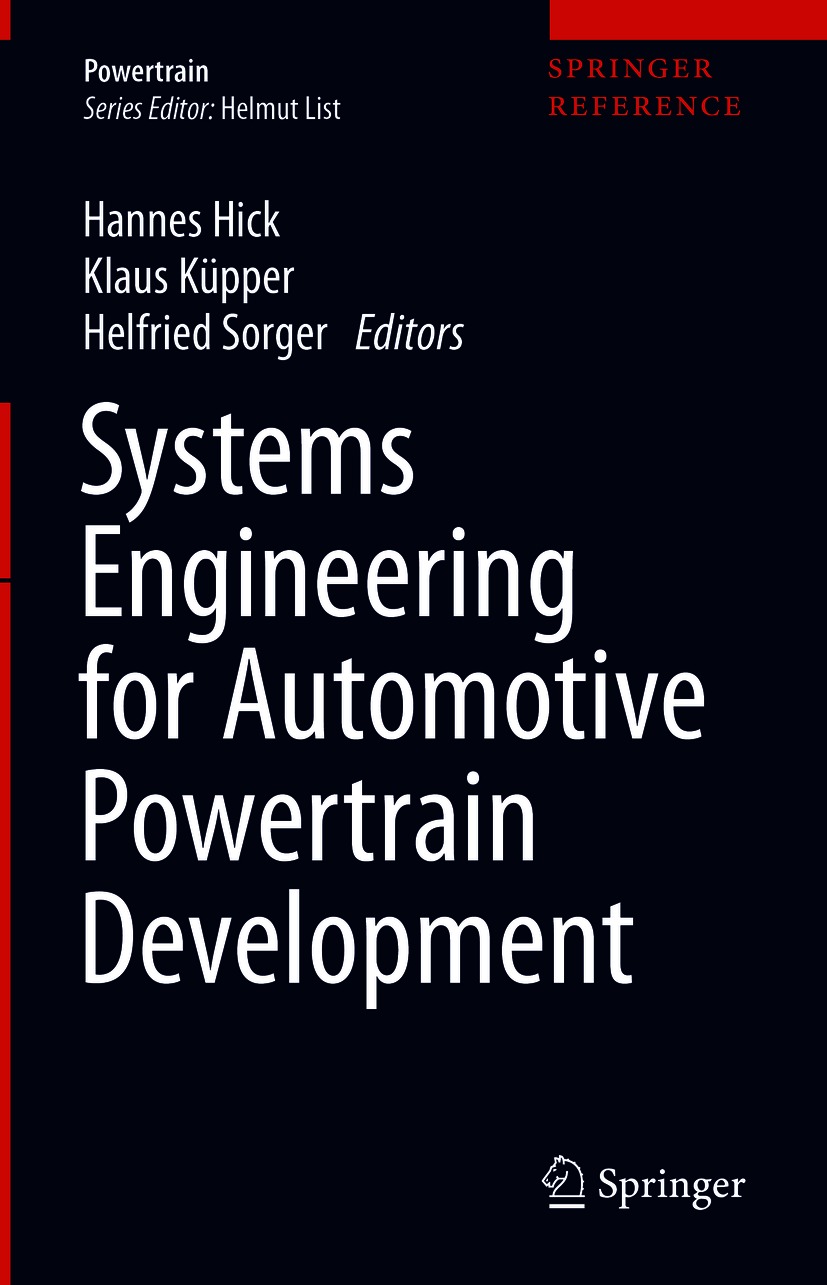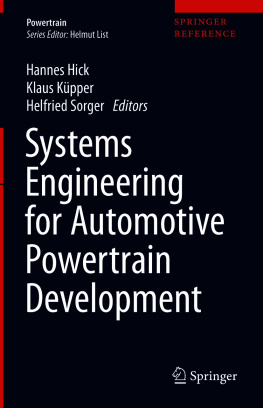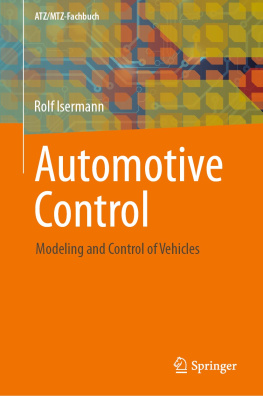Hannes Hick - Systems Engineering for Automotive Powertrain Development
Here you can read online Hannes Hick - Systems Engineering for Automotive Powertrain Development full text of the book (entire story) in english for free. Download pdf and epub, get meaning, cover and reviews about this ebook. publisher: Springer International Publishing, genre: Home and family. Description of the work, (preface) as well as reviews are available. Best literature library LitArk.com created for fans of good reading and offers a wide selection of genres:
Romance novel
Science fiction
Adventure
Detective
Science
History
Home and family
Prose
Art
Politics
Computer
Non-fiction
Religion
Business
Children
Humor
Choose a favorite category and find really read worthwhile books. Enjoy immersion in the world of imagination, feel the emotions of the characters or learn something new for yourself, make an fascinating discovery.
- Book:Systems Engineering for Automotive Powertrain Development
- Author:
- Publisher:Springer International Publishing
- Genre:
- Rating:4 / 5
- Favourites:Add to favourites
- Your mark:
- 80
- 1
- 2
- 3
- 4
- 5
Systems Engineering for Automotive Powertrain Development: summary, description and annotation
We offer to read an annotation, description, summary or preface (depends on what the author of the book "Systems Engineering for Automotive Powertrain Development" wrote himself). If you haven't found the necessary information about the book — write in the comments, we will try to find it.
Hannes Hick: author's other books
Who wrote Systems Engineering for Automotive Powertrain Development? Find out the surname, the name of the author of the book and a list of all author's works by series.
Systems Engineering for Automotive Powertrain Development — read online for free the complete book (whole text) full work
Below is the text of the book, divided by pages. System saving the place of the last page read, allows you to conveniently read the book "Systems Engineering for Automotive Powertrain Development" online for free, without having to search again every time where you left off. Put a bookmark, and you can go to the page where you finished reading at any time.
Font size:
Interval:
Bookmark:

For decades, the series The internal combustion engine (originally published in German language under the title Die Verbrennungskraftmaschine) edited by Hans List and Hans Pischinger was an indispensable reference work for engineers in practice and students at universities. With regard to the fast pace of technology, a new series was created in 2002 and published under the title Powertrain (for German language titles under the title Der Fahrzeugantrieb). These titles focus on the role of today's internal combustion engines as components of propulsion systems.
More information about this series at https://www.springer.com/series/7569

This Springer imprint is published by the registered company Springer Nature Switzerland AG.
The registered company address is: Gewerbestrasse 11, 6330 Cham, Switzerland
In the period between 2013 and early 2014, a new series was created under the title Powertrain, with a new layout and a new Scientific Advisory Board. This series shows the holistic context of the individual components of a powertrain. Several books have already been published. In particular, the English language editions will be promoted next to the German editions.
In this series, classification has been made according to the current areas of responsibility in the industry.
This book series focuses especially on the state of knowledge in the various fields in the industry, starting from the basics and describing the necessary background information. In particular, the new elements of future propulsion systems and their mutual influence and system considerations are addressed. In addition to the technical content, methods and processes for new developments and their boundary conditions are presented. The circumstances of different economies and their respective requirements are set out in concepts.
This book series provides both students at universities and colleges as well as practitioners in the industry with a guidebook from which they can acquire the accumulated experience of the authors knowledge.
Current and future development processes of the various electrified powertrains increase the complexity. This topic and the necessary processes are the content of this book.
The development of complex powertrains is best achieved by applying a systems engineering approach that enables interdisciplinary and comprehensive system development and considers not only the development phase, but also includes the production, in-use, and recycling phases to realize the targets considering development time as well as total life-cycle costs.
Key elements required in the development framework are model-based development, virtual prototyping, and specific test beds for all new powertrain elements, systems, and the entire vehicle. An open-development platform across all domains and disciplines is required to enable the use of virtual prototypes, instead of just physical ones.
I thank the authors who have agreed to share their knowledge in these books and have invested their efforts in writing them. In particular, I would like to thank Prof. Hick for his coordination work for this book. I also want to thank our publisher, Springer, for their cooperation. I am very grateful to the Scientific Advisory Board, which stood by me in both the division of the very broad subject area as well as in the selection of authors. The members of the board are: R. Bastien, vice president, Renault; C. Beidl, professor, Technische Universitt Darmstadt; H. Eichlseder, professor, Graz University of Technology; H. Kohler, former vice president, Daimler; J. Li, vice president, FAW; and R. D. Reitz, professor, University of Wisconsin-Madison
Helmut List
Series Editor
For more than 100 years, the development of automotive powertrains has been dominated by the internal combustion engine (ICE), but that focus is rapidly shifting towards a plurality of propulsive sources. Manufacturers currently find themselves in a transitional phase from purely ICE-based powertrains, moving along a path of varying degrees of electrification resulting in a range of vehicles from hybrids to purely electrically powered vehicles using battery or fuel cell technology.
The wide range of possibilities in the technology portfolio has given rise to uncertainty in planning for the future. It is currently difficult to predict customer behavior in terms of the demand for different types of mobility and also market behavior in terms of the provision of different forms of energy. Added to this are market forces such as the affordability of running an electric vehicle, factors affecting consumer buying power, and the changing relationships between original equipment manufacturers (OEMs) and their suppliers. Legislation governing levels of emitted pollutants and particularly CO2 adds another layer of complexity to an already uncertain situation.
However, there is some certainty in the form of trends, whose trajectory can be well predicted, such as an increase in complexity in product development due to the increased degree of electrification and growth in the field of information and communication technology. This complexity is best managed by interdisciplinary development approaches and a broader implementation of product lifecycle management systems that includes the consideration of the global environmental impact of powertrain solutions.
Font size:
Interval:
Bookmark:
Similar books «Systems Engineering for Automotive Powertrain Development»
Look at similar books to Systems Engineering for Automotive Powertrain Development. We have selected literature similar in name and meaning in the hope of providing readers with more options to find new, interesting, not yet read works.
Discussion, reviews of the book Systems Engineering for Automotive Powertrain Development and just readers' own opinions. Leave your comments, write what you think about the work, its meaning or the main characters. Specify what exactly you liked and what you didn't like, and why you think so.











